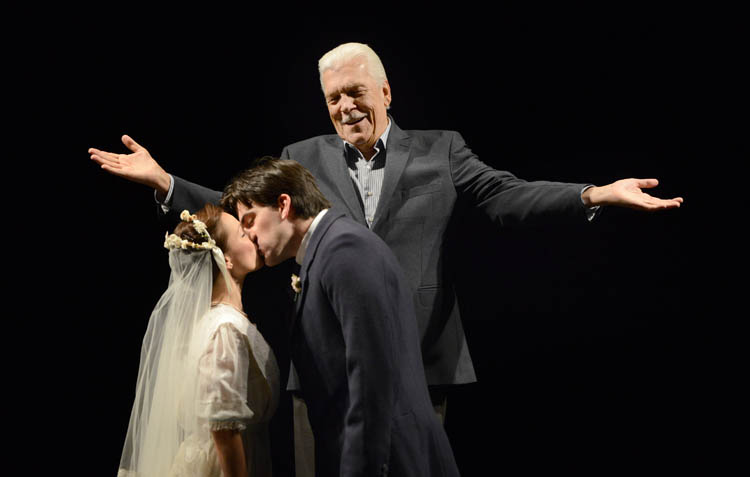PPT’s rendition captures ‘Our Town’s” existential depth
October 10, 2013
“Our Town”
621 Penn Ave., Cultural District
Through Oct. 27
Admission: $29 – $55 general, $15 with Student ID
“Do any human beings ever realize life while they live it?”
The simplicities and complexities of life are seen in narrative descriptions in Thornton Wilder’s 1938 play “Our Town,” which displays the lives of two families in a fictional town in New Hampshire over several years in the early 20th century.
We are allowed access to the lives of two families in Grover’s Corner, N.H. — the Webbs and the Gibbs. Two children, George Gibbs (Patrick Cannon) and Emily Webb (Erin Lindsey Krom) grow up next door to each other, fall in love, get married and face death. Their story outlines the play, creating a cycle that is inherently relatable to a wider human audience.
Each act deals with a specific time in the couple’s lives, corresponding to the previously stated themes. The entire plot is directed by the Stage Manager (Tom Atkins), a sort of narrator who is privy to everything within the town and seems to cue everything into place.
Following Wilder’s original request that there be no set during the play’s performance and that most props be implied by the actors, the Pittsburgh Public Theater created a set that left much to the imagination (in a positive manner). The simplicity of the set and the white arc that delinated the acting space seemed to define a line between past and present, between fiction and reality and between the viewers and the actors in the center of the space.
Indeed, behind the simple set, seemingly mundane plotline and gradual character development, there is a higher, metaphysical current that runs through the work. As the Stage Manager directs the action, telling the audience the theme of each act and giving us insight into both the past and the future, there is a glimpse of the bigger consequences of life and death. He tells the viewer that the play was meant to show what life was like in the early 1900s to an audience of the future.
Though this may seem like a historical retrospective, it is not. Rather, Pittsburgh Public Theater’s production of “Our Town” brings humans from another generation eye to eye with the past, uniting them with relatable themes, feelings and ponderings.
The metaphysical element of the play — the idea that we are all part of something larger but might not take the time to realize it — is summed up by the monologue of the Stage Manager when he notes that “There’s something way down deep that’s eternal about every human being.”
The standout actor in the performance was definitely Atkins, who convincingly played a complex role that was neither in the time of the play nor the time of the viewer, but rather seemed to float in a sort of ethereal realm. He was able to work the stage convincingly, engaging both the audience and the other actors without distorting the reception of the information at hand. However, it can be said that he seemed to outshine the rest of the cast.
Cannon was a bit unconvincing in the role of the adolescent George, as was Krom as the teenage Emily, exposing a weak point in the casting decisions. Indeed, Cannon’s casting as George was very strange. The tall, gangly figure of Cannon awkwardly attempting to portray an adolescent in both maturity level and physicality didn’t quite work. At times, both Krom and Cannon felt like walking caricatures.
The theater company stayed true to Wilder’s original intentions in their portrayal of “Our Town,” creating a sort of breach in time that transports the viewer to another era, but one with relatable themes and life moments. Though their rendition of “Our Town” had a few questionable acting choices, it was a pleasant surprise overall, uniting the past with the present and questioning the decisions made in the lives of men, showing us “we can only be said to be alive in those moments when our hearts are conscious of our treasures.”








